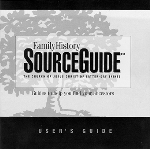
Ask anyone who has worked very long on their family history about major repositories, and you will learn about the Family History Library in Salt Lake City, Utah. Its greatest appeal is not just the fact that it is the largest genealogical library in the world, but that there are thousands of "branch" centers of this large repository nation-wide. You will learn more about your local branch Family History Center in Lesson 12.
By using the Family History Library Catalog (FHLC), you can access the non-electronic holdings of this repository. Also, by learning how to access this library catalog, you will see the value of using other library and archive catalogs on-line as well. The Family History Library Catalog is maintained on the largest Internet site in the world which we will become very familiar with in Lesson 11, but only a small fraction of the information available through this
library is available on the Internet.

The purpose of Lesson 10 is to introduce the Internet and to cover book, microfiche, and microfilm collections of the Family History Library, while Lesson 11 will cover the electronic resources of this repository. The easiest way to learn about the many resources available for the genealogist through the Family History Library in the past was to use a compact disk called SourceGuide. SourceGuide has now been converted to a process called Research Guidance available at www.familysearch.org where you just click on the SEARCH tab at the top of the page and then the words RESEARCH GUIDANCE that appear across the top. Using research guidance and the Family History Library Catalog enables the new user to use this facility well.

Once you are on the Research Guidance page, either scroll down to the state or country you are interested in or click on the letter box that corresponds to the first letter of the name of the country or state you are interested in. Now select the country or state.
Now select the time period of interest to you. When the search strategy comes up study the:
1. Historical background,
2. Methodologies for beginners, and
3. Search strategies.
While these won�t make a professional genealogist out of you, they can prevent you from unknowingly leaving out critical resources known to solve research problems in the areas selected.
|